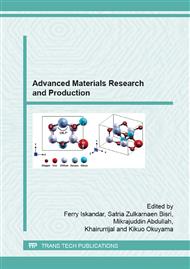p.381
p.385
p.389
p.393
p.397
p.402
p.406
p.410
p.414
The Effect of Silica Nanoparticle Filler and Mg(OH)2 Particle Addition on the Compressive Strength of Rice Husk Composite
Abstract:
Simple mixing and hot pressing methods were used to make nanocomposite of rice husk using PVAc as adhesive, silica nanoparticle as filler and Mg(OH)2 particle . The compressive strength of the composite was examined. The optimum mass ratio composition of rice husk and PVAc was 13 : 2. A compressive strength of 63.95 MPa was obtained for the samples which were pressed at 75 MPa pressure, at 100°C temperature and then held for 15 minutes in the hot pressing machine. The addition of silica nanoparticle increased the compressive strength to 74.65 MPa hence increasing the value by approximately 11%. The addition of Mg(OH)2 particles then decreased the compressive strength to 61.23 MPa therefore decreasing the value about 13%. The compressive strength gained for the rice-husk/PVAc composite with nanosilica filler is stronger than the composite of Kumagai S making it feasible to be used in many applications, especially in furnishings.
Info:
Periodical:
Pages:
397-401
Citation:
Online since:
July 2015
Keywords:
Price:
Сopyright:
© 2015 Trans Tech Publications Ltd. All Rights Reserved
Share:
Citation:


